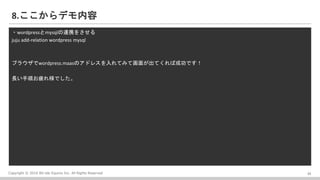Hack the juju_maas_interop用デモ資料
- 1. Copyright ? 2016 Bit-isle Equinix Inc. All Rights Reserved HACK! THE Juju/MAAS デモ資料 ビットアイル?エクイニクス 山下 祐生
- 2. Copyright ? 2016 Bit-isle Equinix Inc. All Rights Reserved 自己紹介 ?名前:山下祐生 ?年齢:25歳 ?所属:ビットアイル?エクイニクス ?職種:OpenStack Enginner ?社会人歴:3年 ?経歴:某大手NIerに新卒入社し3年勤務したあと、 4月からビットアイルに入社 ?最近ハマっていること Juju/MAAS 1
- 3. Copyright ? 2016 Bit-isle Equinix Inc. All Rights Reserved 2
- 4. Copyright ? 2016 Bit-isle Equinix Inc. All Rights Reserved デモ構成
- 5. Copyright ? 2016 Bit-isle Equinix Inc. All Rights Reserved OSインストールアプリデプロイ
- 6. Copyright ? 2016 Bit-isle Equinix Inc. All Rights Reserved OSインストールアプリデプロイ デモではリレー ションを実施する
- 7. Copyright ? 2016 Bit-isle Equinix Inc. All Rights Reserved Juju/MAASの何が嬉しいの?
- 8. Copyright ? 2016 Bit-isle Equinix Inc. All Rights Reserved Juju/MAASの嬉しいところ ?MAAS ? APIがある ? ノードをタグやスペックで管理ができる ? MAASのセグメントにつなげたマシンの電源を入れるだけで登録される ? 様々なOSのデプロイが可能 ?Juju ? とりあえず試してみたいプロダクトをらくらくインストール ? 複雑なサーバ間の連携もコマンド一発 ? Ubuntuコミュニティのナレッジ簡単アクセス 7
- 9. Copyright ? 2016 Bit-isle Equinix Inc. All Rights Reserved 付録
- 10. Copyright ? 2016 Bit-isle Equinix Inc. All Rights Reserved デモ環境を作成ハンズオン ?用意するもの ?一台のUbuntu14.04 Desktopマシン(GUIが無いと大変です) ? CPU:2Core 4Thread IntelVT対応 ? MEM:8GB ? DISK:100GB ? Ubuntu14.04.4LTS ?Ubuntu 14.04.4LTSのiso ? http://releases.ubuntu.com/14.04/ ※コマンドの色分け ホストマシンで実行の手順は黒文字 MAASインスタンス上で実行の手順はオレンジ 9
- 11. Copyright ? 2016 Bit-isle Equinix Inc. All Rights Reserved 1.パッケージインストールと初期設定 ?KVM install sudo apt-get install libvirt-bin virtinst virt-manager ?maas-client install sudo apt-get install maas-cli ?juju-core install sudo apt-get install juju-core ?鍵の設定 ssh-keygen mv ~/.ssh/id_rsa.pub ~/.ssh/authorized_keys sudo chmod 600 ~/.ssh/authorized_keys sudo chmod 600 ~/.ssh/id_rsa 10
- 12. Copyright ? 2016 Bit-isle Equinix Inc. All Rights Reserved 2.KVM設定 ?defaultネットワークを変更する virsh net-edit default <dhcp></dhcp>で囲われている部分をすべて削除 ※MAASがDHCPを流すためにOFFにする必要がある ?設定の反映 sudo virsh net-define /etc/libvirt/qemu/networks/default.xml ?wgetしてきたubuntu imageを所定のディレクトリに配置 sudo mv ~/Download/ubuntu-14.04.4-server-amd64.iso /var/lib/libvirt/images/ 11
- 13. Copyright ? 2016 Bit-isle Equinix Inc. All Rights Reserved 3.MAASインストール ?virt-managerを使ってインスタンスを作成 ? ISOでインストールを選択 ? スペックはCPU2Core,Mem:2048,Disk30GB(qcow2),netowrk:NAT(defaultネットワーク) ? IP addressは192.168.122.2を設定、gatewayは192.168.122.1、DNSは8.8.8.8 ※Ubuntuのインストールは普段使っているオプションでのUbuntuのインストールでOK ?MAASのレポジトリをインストール sudo apt-get install software-properties-common sudo add-apt-repository ppa:maas/stable ?MAASのインストール sudo apt-get install maas 12
- 14. Copyright ? 2016 Bit-isle Equinix Inc. All Rights Reserved 4.MAASの設定 ?MAASアカウントの作成 sudo maas-region-admin createadmin ※ユーザー名はubuntuでお願いします ?maasコマンドのセットアップの準備 sudo maas-region-admin apikey --username=ubuntu ※apikeyをメモっておく ?ホストマシンでmaasコマンドのセットアップ maas login m http://192.168.122.2/MAAS/api/1.0 [apikey] ?イメージのインポート実行 maas m boot-source-selections create 1 os="ubuntu" release="trusty" arches="amd64" subarches="*" labels="*" maas m boot-source-selections create 1 os="ubuntu" release="xenial" arches="amd64" subarches="*" labels="*“ maas m boot-resources import 13
- 15. Copyright ? 2016 Bit-isle Equinix Inc. All Rights Reserved 4.MAASの設定 ?MAASがデプロイするサーバ用の公開鍵作成 cat ~/.ssh/authorized_keys |xargs -I% maas m sshkeys new key="%“ ?MAAS-DHCPの設定 uuid=$(maas m node-groups list | grep uuid | cut -d" -f4) maas m node-group-interface delete $uuid eth0 maas m node-group-interfaces new $uuid ip_range_high=192.168.122.200 ip_range_low=192.168.122.10 management=2 static_ip_range_low=192.168.122.201 name=eth0 ip=192.168.122.2 subnet_mask=255.255.255.0 broadcast_ip=192.168.122.255 static_ip_range_high=192.168.122.251 interface=eth0 14
- 16. Copyright ? 2016 Bit-isle Equinix Inc. All Rights Reserved 4.MAASの設定 ?DHCPの設定を確認 maas m node-group-interface read $uuid eth0 Success. Machine-readable output follows: { "ip_range_high": "192.168.122.200", "ip_range_low": "192.168.122.10", "management": 2, "static_ip_range_low": "192.168.122.201", "name": "eth0", "ip": "192.168.122.2", "subnet_mask": "255.255.255.0", "broadcast_ip": "192.168.122.255", "static_ip_range_high": "192.168.122.251", "interface": "eth0" } 15
- 17. Copyright ? 2016 Bit-isle Equinix Inc. All Rights Reserved 4.MAASの設定 ?virshコマンドをmaasがホストに対して叩ける用に鍵の設定 scp ~/.ssh/authorized_keys ubuntu@192.168.122.2:~/.ssh/ scp ~/.ssh/id_rsa ubuntu@192.168.122.2:~/.ssh/ ?ホストマシンのDNSをMAASに向ける sudo vim /etc/resolv.conf nameserver 192.168.122.2 ?MAASのディレクトリに鍵を配置 sudo cp -p ~/.ssh/id_rsa ~/maas/.ssh/ sudo chown maas. ~/maas/.ssh/ sudo chmod 600 ~/maas/.ssh/ ?virshが叩けることを確認 sudo -u maas virsh -c qemu+ssh://ubuntu@192.168.122.1/system list ?再起動 sudo reboot 16
- 18. Copyright ? 2016 Bit-isle Equinix Inc. All Rights Reserved 5.Jujuのインストール ?Jujuのinitをする juju init ?Jujuのコンフィグファイル生成 mv ~/.juju/environments.yaml ~/.juju/environments.yaml.bak vim ~/.juju/environments.yaml default: cloud1 environments: cloud1: type: maas maas-server: 'http://192.168.122.2/MAAS' maas-oauth: '[apikeyの中身を入力]' bootstrap-timeout: 3600 17
- 19. Copyright ? 2016 Bit-isle Equinix Inc. All Rights Reserved 5.Jujuのインストール ?Jujuの仮想マシンを作成 sudo virt-install --name juju --ram=1024 --disk path=/var/lib/libvirt/images/juju.img,size=15 --vcpus 1 --os-type linux --network network=default --noautoconsole --graphics spice --pxe ※MAASに新しいマシンがNEW状態で登録されたら、ダッシュボードから自動生成された名前からjujuに変更する ?jujuマシンのパワーパラメータの変更 maas m node update $(maas m nodes list hostname=juju|jq -r ".[].system_id") power_type=virsh power_parameters_power_address="qemu+ssh://ubuntu@192.168.122.1/system" power_parameters_power_id=juju 18
- 20. Copyright ? 2016 Bit-isle Equinix Inc. All Rights Reserved 5.Jujuのインストール ?Jujuマシンが毎回PXEブートをするように修正 sudo sed -i "s: <boot dev='hd'/>: <boot dev='network'/>:g" /etc/libvirt/qemu/juju.xml sudo virsh define /etc/libvirt/qemu/juju.xml ?Jujuマシンのコミッショニング maas m node commission $(maas m nodes list hostname=juju|jq -r ".[].system_id") enable_ssh=1 ※コミッショニングが成功するまで待機 ?Jujuマシンにbootstrapタグを付ける maas m tags new name=bootstrap maas m tag update-nodes juju add=$(maas m nodes list hostname=juju|jq -r ".[].system_id") ?Jujuを仮想マシンにデプロイ juju bootstrap --show-log --constraints tags=bootstrap --debug -e cloud1 --upload-tools=true ?Jujuがきちんと動いているか確認 juju stat --format tabular 19
- 21. Copyright ? 2016 Bit-isle Equinix Inc. All Rights Reserved 6.Wordpress用マシンの作成 ?仮想マシンの作成 sudo virt-install --name wordpress --ram=1024 --disk path=/var/lib/libvirt/wordpress.img,size=15 --vcpus 1 --os-type linux --network network=default --noautoconsole --graphics spice --pxe ※MAASに新しいマシンがNEW状態で登録されたら、ダッシュボードで自動生成された名前からwordpress1に変更する ?wordpressマシンのパワーパラメータの変更 maas m node update $(maas m nodes list hostname=wordpress1|jq -r ".[].system_id") power_type=virsh power_parameters_power_address="qemu+ssh://ubuntu@192.168.122.1/system" power_parameters_power_id=wordpress 20
- 22. Copyright ? 2016 Bit-isle Equinix Inc. All Rights Reserved 6.Wordpress用マシンの作成 ?wordpressマシンが毎回PXEブートをするように修正 sudo sed -i "s: <boot dev='hd'/>: <boot dev='network'/>:g" /etc/libvirt/qemu/wordpress.xml sudo virsh define /etc/libvirt/qemu/wordpress.xml ?wordpressマシンのコミッショニング maas m node commission $(maas m nodes list hostname=wordpress1|jq -r ".[].system_id") enable_ssh=1 ※コミッショニングが成功するまで待機 ?wordpressマシンにwordpressタグを付ける maas m tags new name=wordpress maas m tag update-nodes wordpress1 add=$(maas m nodes list hostname=wordpress1|jq -r ".[].system_id") ?wordpressを仮想マシンにデプロイ juju deploy --constraints tags=wordpress wordpress 21
- 23. Copyright ? 2016 Bit-isle Equinix Inc. All Rights Reserved 7.DB用マシンの作成 ?仮想マシンの作成 sudo virt-install --name db --ram=1024 --disk path=/var/lib/libvirt/images/db.img,size=15 --vcpus 1 --os-type linux --network network=default --noautoconsole --graphics spice --pxe ※MAASに新しいマシンがNEW状態で登録されたら、ダッシュボードで自動生成された名前からdbに変更する ?DBマシンのパワーパラメータの変更 maas m node update $(maas m nodes list hostname=db|jq -r ".[].system_id") power_type=virsh power_parameters_power_address="qemu+ssh://kono@192.168.122.1/system" power_parameters_power_id=db 22
- 24. Copyright ? 2016 Bit-isle Equinix Inc. All Rights Reserved 7.DB用マシンの作成 ?DBマシンが毎回PXEブートをするように修正 sudo sed -i "s: <boot dev='hd'/>: <boot dev='network'/>:g" /etc/libvirt/qemu/db.xml sudo virsh define /etc/libvirt/qemu/db.xml ?DBマシンのコミッショニング maas m node commission $(maas m nodes list hostname=db|jq -r ".[].system_id") enable_ssh=1 ※コミッショニングが成功するまで待機 ?DBマシンにdbタグを付ける maas m tags new name=db maas m tag update-nodes db add=$(maas m nodes list hostname=db|jq -r ".[].system_id") ?Mysqlを仮想マシンにデプロイ juju deploy --constraints tags=db mysql 23
- 25. Copyright ? 2016 Bit-isle Equinix Inc. All Rights Reserved 8.ここからデモ内容 ?wordpressとmysqlの連携をさせる juju add-relation wordpress mysql ブラウザでwordpress.maasのアドレスを入れてみて画面が出てくれば成功です! 長い手順お疲れ様でした。 24






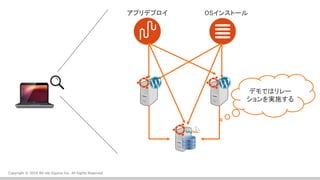

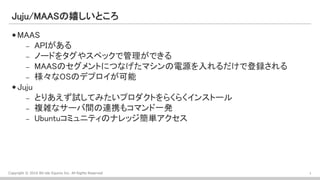

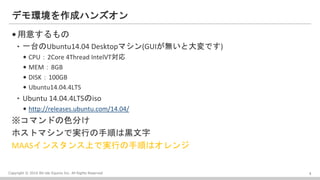
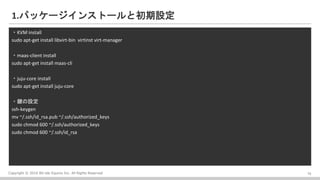

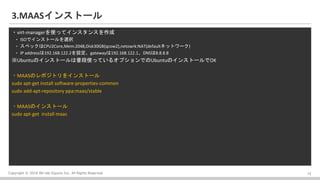
![Copyright ? 2016 Bit-isle Equinix Inc. All Rights Reserved
4.MAASの設定
?MAASアカウントの作成
sudo maas-region-admin createadmin
※ユーザー名はubuntuでお願いします
?maasコマンドのセットアップの準備
sudo maas-region-admin apikey --username=ubuntu
※apikeyをメモっておく
?ホストマシンでmaasコマンドのセットアップ
maas login m http://192.168.122.2/MAAS/api/1.0 [apikey]
?イメージのインポート実行
maas m boot-source-selections create 1 os="ubuntu" release="trusty" arches="amd64" subarches="*" labels="*"
maas m boot-source-selections create 1 os="ubuntu" release="xenial" arches="amd64" subarches="*" labels="*“
maas m boot-resources import
13](https://image.slidesharecdn.com/hackthejujumaasinterop-160610131053/85/Hack-the-juju_maas_interop-14-320.jpg)
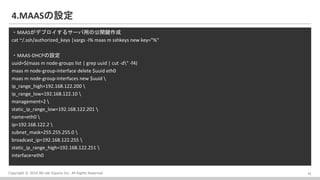
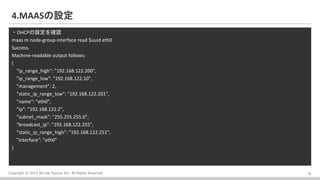
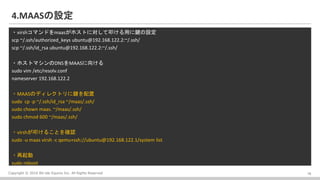
![Copyright ? 2016 Bit-isle Equinix Inc. All Rights Reserved
5.Jujuのインストール
?Jujuのinitをする
juju init
?Jujuのコンフィグファイル生成
mv ~/.juju/environments.yaml ~/.juju/environments.yaml.bak
vim ~/.juju/environments.yaml
default: cloud1
environments:
cloud1:
type: maas
maas-server: 'http://192.168.122.2/MAAS'
maas-oauth: '[apikeyの中身を入力]'
bootstrap-timeout: 3600
17](https://image.slidesharecdn.com/hackthejujumaasinterop-160610131053/85/Hack-the-juju_maas_interop-18-320.jpg)
![Copyright ? 2016 Bit-isle Equinix Inc. All Rights Reserved
5.Jujuのインストール
?Jujuの仮想マシンを作成
sudo virt-install
--name juju
--ram=1024
--disk path=/var/lib/libvirt/images/juju.img,size=15
--vcpus 1
--os-type linux
--network network=default
--noautoconsole
--graphics spice
--pxe
※MAASに新しいマシンがNEW状態で登録されたら、ダッシュボードから自動生成された名前からjujuに変更する
?jujuマシンのパワーパラメータの変更
maas m node update $(maas m nodes list hostname=juju|jq -r ".[].system_id") power_type=virsh
power_parameters_power_address="qemu+ssh://ubuntu@192.168.122.1/system" power_parameters_power_id=juju
18](https://image.slidesharecdn.com/hackthejujumaasinterop-160610131053/85/Hack-the-juju_maas_interop-19-320.jpg)
![Copyright ? 2016 Bit-isle Equinix Inc. All Rights Reserved
5.Jujuのインストール
?Jujuマシンが毎回PXEブートをするように修正
sudo sed -i "s: <boot dev='hd'/>: <boot dev='network'/>:g" /etc/libvirt/qemu/juju.xml
sudo virsh define /etc/libvirt/qemu/juju.xml
?Jujuマシンのコミッショニング
maas m node commission $(maas m nodes list hostname=juju|jq -r ".[].system_id") enable_ssh=1
※コミッショニングが成功するまで待機
?Jujuマシンにbootstrapタグを付ける
maas m tags new name=bootstrap
maas m tag update-nodes juju add=$(maas m nodes list hostname=juju|jq -r ".[].system_id")
?Jujuを仮想マシンにデプロイ
juju bootstrap --show-log --constraints tags=bootstrap --debug -e cloud1 --upload-tools=true
?Jujuがきちんと動いているか確認
juju stat --format tabular
19](https://image.slidesharecdn.com/hackthejujumaasinterop-160610131053/85/Hack-the-juju_maas_interop-20-320.jpg)
![Copyright ? 2016 Bit-isle Equinix Inc. All Rights Reserved
6.Wordpress用マシンの作成
?仮想マシンの作成
sudo virt-install
--name wordpress
--ram=1024
--disk path=/var/lib/libvirt/wordpress.img,size=15
--vcpus 1
--os-type linux
--network network=default
--noautoconsole
--graphics spice
--pxe
※MAASに新しいマシンがNEW状態で登録されたら、ダッシュボードで自動生成された名前からwordpress1に変更する
?wordpressマシンのパワーパラメータの変更
maas m node update $(maas m nodes list hostname=wordpress1|jq -r ".[].system_id") power_type=virsh
power_parameters_power_address="qemu+ssh://ubuntu@192.168.122.1/system" power_parameters_power_id=wordpress
20](https://image.slidesharecdn.com/hackthejujumaasinterop-160610131053/85/Hack-the-juju_maas_interop-21-320.jpg)
![Copyright ? 2016 Bit-isle Equinix Inc. All Rights Reserved
6.Wordpress用マシンの作成
?wordpressマシンが毎回PXEブートをするように修正
sudo sed -i "s: <boot dev='hd'/>: <boot dev='network'/>:g" /etc/libvirt/qemu/wordpress.xml
sudo virsh define /etc/libvirt/qemu/wordpress.xml
?wordpressマシンのコミッショニング
maas m node commission $(maas m nodes list hostname=wordpress1|jq -r ".[].system_id") enable_ssh=1
※コミッショニングが成功するまで待機
?wordpressマシンにwordpressタグを付ける
maas m tags new name=wordpress
maas m tag update-nodes wordpress1 add=$(maas m nodes list hostname=wordpress1|jq -r ".[].system_id")
?wordpressを仮想マシンにデプロイ
juju deploy --constraints tags=wordpress wordpress
21](https://image.slidesharecdn.com/hackthejujumaasinterop-160610131053/85/Hack-the-juju_maas_interop-22-320.jpg)
![Copyright ? 2016 Bit-isle Equinix Inc. All Rights Reserved
7.DB用マシンの作成
?仮想マシンの作成
sudo virt-install
--name db
--ram=1024
--disk path=/var/lib/libvirt/images/db.img,size=15
--vcpus 1
--os-type linux
--network network=default
--noautoconsole
--graphics spice
--pxe
※MAASに新しいマシンがNEW状態で登録されたら、ダッシュボードで自動生成された名前からdbに変更する
?DBマシンのパワーパラメータの変更
maas m node update $(maas m nodes list hostname=db|jq -r ".[].system_id") power_type=virsh
power_parameters_power_address="qemu+ssh://kono@192.168.122.1/system" power_parameters_power_id=db
22](https://image.slidesharecdn.com/hackthejujumaasinterop-160610131053/85/Hack-the-juju_maas_interop-23-320.jpg)
![Copyright ? 2016 Bit-isle Equinix Inc. All Rights Reserved
7.DB用マシンの作成
?DBマシンが毎回PXEブートをするように修正
sudo sed -i "s: <boot dev='hd'/>: <boot dev='network'/>:g" /etc/libvirt/qemu/db.xml
sudo virsh define /etc/libvirt/qemu/db.xml
?DBマシンのコミッショニング
maas m node commission $(maas m nodes list hostname=db|jq -r ".[].system_id") enable_ssh=1
※コミッショニングが成功するまで待機
?DBマシンにdbタグを付ける
maas m tags new name=db
maas m tag update-nodes db add=$(maas m nodes list hostname=db|jq -r ".[].system_id")
?Mysqlを仮想マシンにデプロイ
juju deploy --constraints tags=db mysql
23](https://image.slidesharecdn.com/hackthejujumaasinterop-160610131053/85/Hack-the-juju_maas_interop-24-320.jpg)
